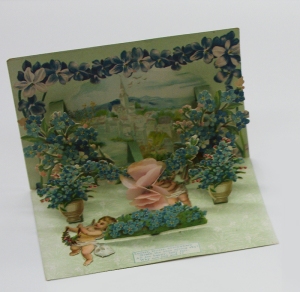Cookies in Collections
Ready to cook up a holiday tradition? Learn more about artifacts related to baking cookies in the collections of the Ohio History Connection.
Valentine from the collections of the Ohio Historical Society
Early Valentines Sending loving greetings or love tokens is a practice that has ancient origins. These early cards and tokens were typically handmade. The practice of making and giving handmade cards has continued to the present.
The Golden Age: 1840s – 1890s Valentines that were Put Together By Hand were not mass produced.
In small workshops men and boys typically ran machinery like printing presses, while women and girls hand assembled increasingly elaborate cards with layers of embossed and cut papers; gilt and silvered borders; and chromolithographic scraps. Many of the embossed and cut papers were made in Europe.Some new elements introduced at this time were paper springs that created a lift up effect and colored papers placed underneath the paper lace.
Dimensions and Mechanics Dimensional is a terms used by collectors to describe cards that pop up or even stand. Mechanical is a term used by collectors to describe cards that have moving parts.

Paper honey combs were a popular element for Valentine cards in the late 18th and early 19th centuries.
Common Motifs
Many of the same motifs are common in Valentines for many decades.
Cupids
Birds
Young
Children
Animals
Flowers
Popular Culture: Valentines are Products of their Time
A child’s Valentine from 1940 features Dopey the Dwarf from the movie Snow White and the Seven Dwarfs released in 1937. Popeye and Shirley Temple were other early characters to appear on Valentines in the 1930s and 1940s.
A 1944 Valentine uses a pun on canning. During World War II planting Victory Gardens and canning vegetables was popular.
Some Motifs Do Not Stand the Test of Time
The child’s card with a reference to smoking and Lucky Strike cigarettes would not be well received today.
Cards from the early 20th century depicting caricatures of African Americans and Native Americans would also be seen as dated and offensive.
Greeting Card Companies Companies such as Hallmark, American Greetings and Norcross came into being in the early 20th century. Cards were increasingly mass produced and the cost became cheaper. However, very elaborate Valentines were still produced.
Valentine Postcards The postcard craze that began in the early 1900s and lasted until the 1930s lead to many Valentine and other holiday cards being printed in this format.
Postcards could be mailed for just one penny and could be delivered the next day when sent short distances.
Care of Valentines
Valentines can hold up well if handled carefully and stored properly.
Wash hands or wear gloves when handling.
Keep each card in an individual enclosure.
Lace paper cards are better stored in plastic sleeves that do not need to be removed for viewing. Pulling lace paper cards in and out of enclosures can pull and rip the paper.
Heavier cards attached to scrap book pages will pull from the paper over time.